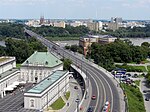Warsaw Zoo

The Warsaw Zoological Garden, known simply as the Warsaw Zoo (Polish: Miejski Ogród Zoologiczny w Warszawie), is a scientific zoo located alongside the Vistula River in Warsaw, Poland. The zoo covers about 40 hectares (99 acres) in central Warsaw, and sees around 1,000,000 visitors annually, making it one of the busiest zoos in Europe. It is home to over 11,000 animals representing more than 500 species.The zoo is an accredited member of the European Association of Zoos and Aquaria (EAZA) and the World Association of Zoos and Aquariums (WAZA).The Warsaw Zoo served as a hiding spot for Jews and escapees from the Warsaw Ghetto during World War II. Zookeepers Jan and Antonina Żabiński, responsible for saving hundreds of Jews within the zoo premises, were eventually granted the title of Righteous Among the Nations for their contribution, effort and good will. These events were documented in the novel The Zookeeper's Wife by Diane Ackerman and in the 2017 war drama film starring Jessica Chastain.
Excerpt from the Wikipedia article Warsaw Zoo (License: CC BY-SA 3.0, Authors, Images).Warsaw Zoo
Ratuszowa, Warsaw Praga-Północ (Warsaw)
Geographical coordinates (GPS) Address Website External links Nearby Places Show on map
Geographical coordinates (GPS)
| Latitude | Longitude |
|---|---|
| N 52.257777777778 ° | E 21.022222222222 ° |
Address
Warszawski Ogród Zoologiczny
Ratuszowa 1/3
03-461 Warsaw, Praga-Północ (Warsaw)
Masovian Voivodeship, Poland
Open on Google Maps











